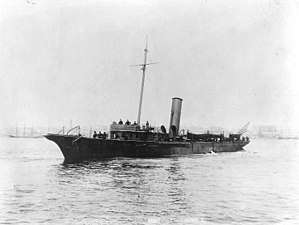Third Battle of Manzanillo
The Third Battle of Manzanillo was a battle fought in the harbor of Manzanillo, Cuba on July 18, 1898. A large squadron of the United States Navy consisting of gunboats and auxiliaries attacked and cleared the harbor of a comparable force of Spanish vessels in the third largest naval battle of the Spanish–American War.
Background
Manzanillo had been a refuge for blockade runners and gunboats since the beginning of the war, and the United States Navy had sent two reconnaissance expeditions to the harbor to determine its defenses. An expedition made up of the gunboats USS Hist and USS Hornet and the armed tug USS Wompatuck attempted to clear the harbor on 30 June 1898 in the First Battle of Manzanillo and a second force made up of the armed tug USS Osceola and the patrol yacht USS Scorpion was sent and repulsed in the Second Battle of Manzanillo on 1 July 1898. Both attacks on the harbor were failed due to the presence of superior Spanish Navy forces.[1] What few Spanish ships were sunk in these attacks were refloated and repaired leaving the largest remaining Spanish naval force in Cuba relatively intact. As a result of the failure of the two previous squadrons to eliminate the Spanish gunboats at Manzanillo, Commander Marix requested that armored vessels to be sent in order to ensure the next assault would be successful. Although Marix had requested heavier units, the Navy sent him the gunboats USS Wilmington and USS Helena.[2] The American squadron, now under the command of Captain Chapman C. Todd,[3] commanding officer of Wilmington, set off on 18 July 1898 to clear Manzanillo harbor of Spanish ships once and for all. The harbor was defended by a fort and shore battery with ten guns.[4]
Battle
The American commander split his force into three sections so as to prevent any Spanish forces from escaping the harbor. The two gunboats Wilmington and Helena entered via a channel on the northern side of the bay attacking from the left, Osceola and Scorpion attacked from a channel directly opposite the city, and the other three American vessels moved in from the right through one of the bays southern channels. All three of the American squadrons timed their passages through the channels to enter the bay concurrently.[5] At 7:04 the battle began when Spanish batteries in the city sighted the Americans and opened fire, some 15 minutes later Scorpion and Osceola replied by attacking the shore batteries.[6] As soon as they were in range Wilmington and Helena began attacking the merchant steamers El Gloria and Jose Garcia as well as the blockade runner El Purísima Concepción. Several of the Spanish gunboats in the harbor sailed out to challenge the American fleet but were repulsed by heavy fire.[7] Hist, Hornet, and Wompatuck pursued the gunboats to their moorings and engaged them.[8]
The American vessels continued to advance on the harbor but were hampered because of the shallow depth of Manzillio's bay, forcing them to reconnoiter passages so that the deeper-drafted gunboats would not beach themselves. Advancing upon the Spanish positions, Commander Todd realized that his forces were focusing too much of their fire upon transports taking refuge in the harbor as well as the hulk Maria, which had been converted to an armed immobile pontoon, so he ordered the Helena to engage the more dangerous gunboats instead of assisting the Wilmington in engaging the targets of lesser importance. Helena then changed targets and began to systematically engage the Spanish gunboats. Three of these caught fire and exploded while one grounded on the beach and sank while another grounded and was thought to have been disabled; she was later scuttled. By the end of the battle the entire Spanish flotilla at Manzanillo had been destroyed or disabled. At 10:22 Todd gave the order for the American forces to withdraw and had the Helena lay down suppressing fire while the rest of the squadron sailed out of the harbor.[9]
Aftermath
By 10:35 the battle was over. The Spanish lost four gunboats, three transports and three pontoons, while the Americans took no casualties. The only significant damage the Americans took was a three-pounder gun that broke loose from its rivets on the Wompatuck though one of USS Wilmington's guns was disabled due to enemy fire for a few minutes.[10] The threat posed by the Spanish flotilla was eliminated, and the American squadron returned to the main fleet, with Wompatuck leaving the rest of the victorious vessels and instead arriving at Guantanamo Bay to bring the Admiral news of the latest American victory. Although the Spanish naval presence in Manzanillo was eliminated, Spanish troops still controlled the town, and it would not be until the very end of the war that Manzanillo fell to American troops after a fierce bombardment of the city and attack by Cuban insurgents.[11]
Order of battle
Citations
- Everett, 141
- McKinley, 261
- Naval History and Heritage Command "Naval Operations Manzanillo"
- Everett, 141
- New York Times, 1
- McKinley, 265
- Everett, 142
- McKinley, 263
- Everett, 143
- DANFS, Wompatuck
- McKinley, 306
References
This article includes information collected from the Naval Vessel Register, which, as a U.S. government publication, is in the public domain.
- Everett, Marshall (1899). Exciting Experiences in Our Wars with Spain and the Filipinos. by Book Publishers Union.
- "Wompatuck". DANFS. U.S. Naval Historical Center. Retrieved 2009-11-08.
- How Todd Sunk Seven Ships (PDF). New York Times. July 22, 1898. p. 1.
- McKinley, William (1899). The Abridgement. Washington, DC: Government Printing Office.
